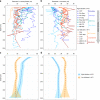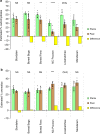Tropical peatland carbon storage linked to global latitudinal trends in peat recalcitrance
- PMID: 30194308
- PMCID: PMC6128871
- DOI: 10.1038/s41467-018-06050-2
Tropical peatland carbon storage linked to global latitudinal trends in peat recalcitrance
Abstract
Peatlands represent large terrestrial carbon banks. Given that most peat accumulates in boreal regions, where low temperatures and water saturation preserve organic matter, the existence of peat in (sub)tropical regions remains enigmatic. Here we examined peat and plant chemistry across a latitudinal transect from the Arctic to the tropics. Near-surface low-latitude peat has lower carbohydrate and greater aromatic content than near-surface high-latitude peat, creating a reduced oxidation state and resulting recalcitrance. This recalcitrance allows peat to persist in the (sub)tropics despite warm temperatures. Because we observed similar declines in carbohydrate content with depth in high-latitude peat, our data explain recent field-scale deep peat warming experiments in which catotelm (deeper) peat remained stable despite temperature increases up to 9 °C. We suggest that high-latitude deep peat reservoirs may be stabilized in the face of climate change by their ultimately lower carbohydrate and higher aromatic composition, similar to tropical peats.
Conflict of interest statement
The authors declare no competing interests.
Figures






References
-
- Yu Z, Loisel J, Brosseau DP, Beilman DW, Hunt SJ. Global peatland dynamics since the Last Glacial Maximum. Geophys. Res. Lett. 2010;37:L13402.
-
- Page SE, Rieley JO, Banks CJ. Global and regional importance of the tropical peatland carbon pool. Glob. Change Biol. 2011;17:798–818. doi: 10.1111/j.1365-2486.2010.02279.x. - DOI
-
- Dommain R, Couwenberg J, Glaser PH, Joosten H, Suryadiputra INN. Carbon storage and release in Indonesian peatlands since the last deglaciation. Quat. Sci. Rev. 2014;97:1–32. doi: 10.1016/j.quascirev.2014.05.002. - DOI
-
- Clymo RS. The limits to peat bog growth. Philos. Trans. R. Soc. Lond. Ser. B. 1984;303:605–654. doi: 10.1098/rstb.1984.0002. - DOI
Publication types
LinkOut - more resources
Full Text Sources
Other Literature Sources

